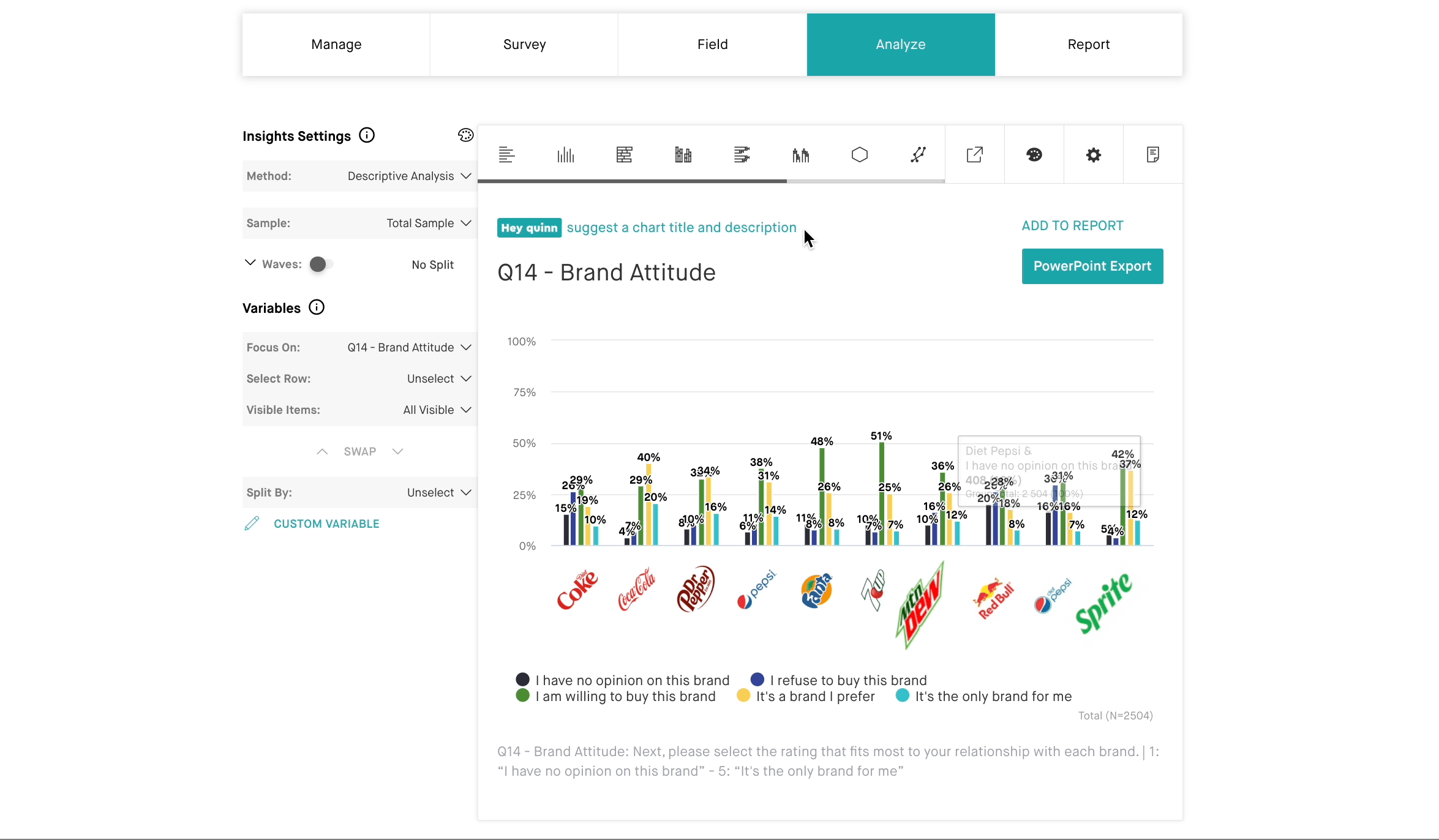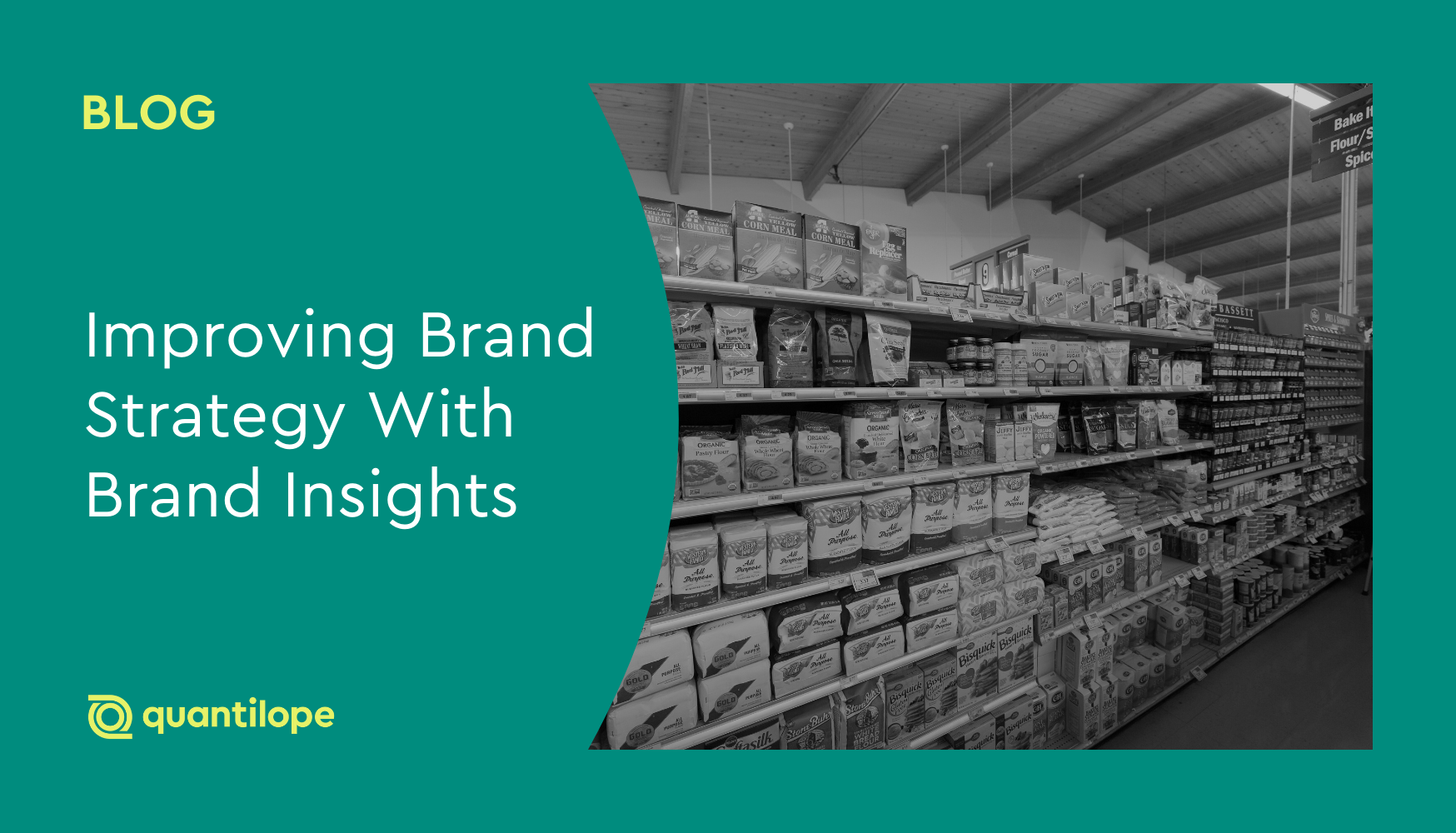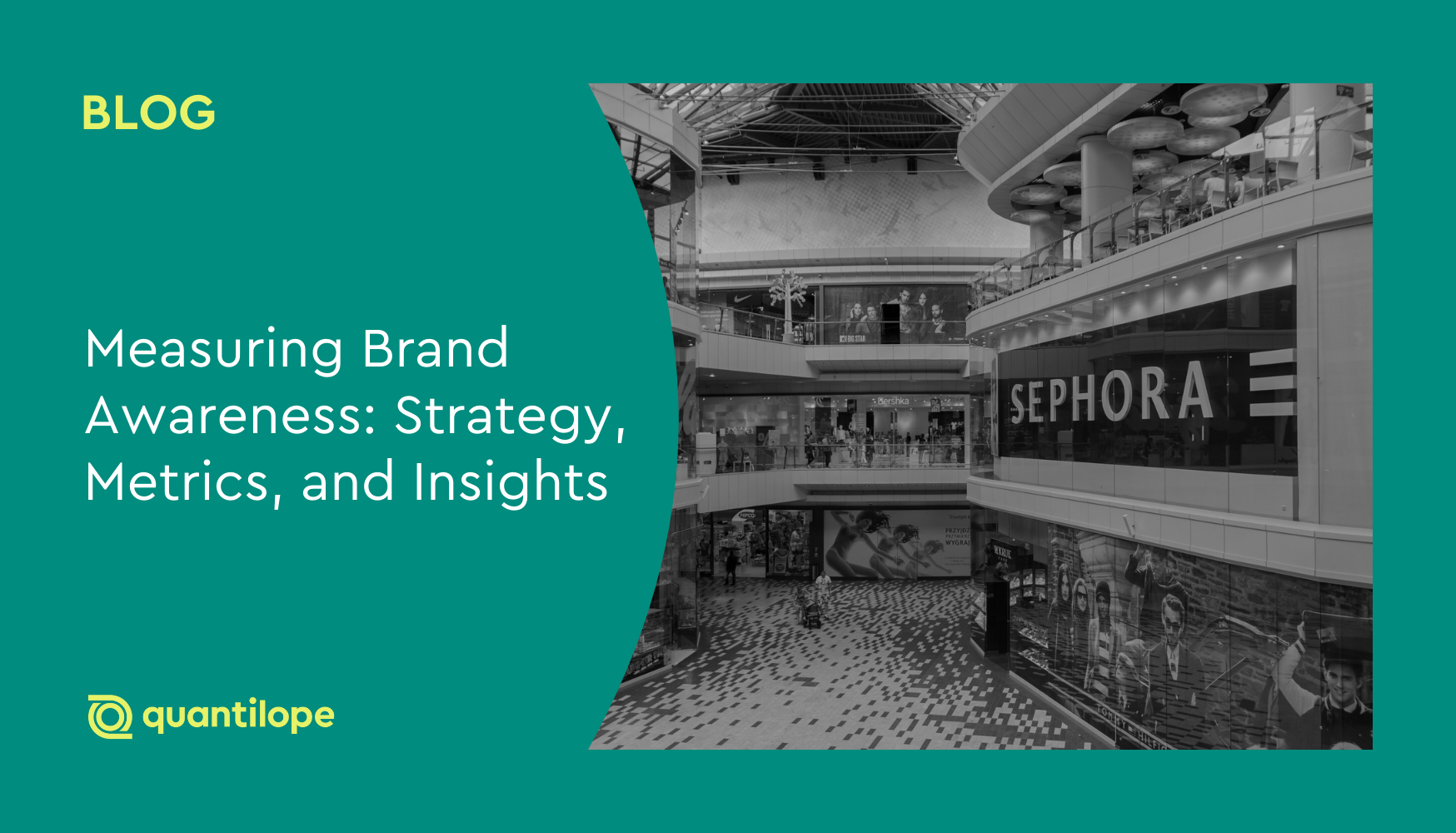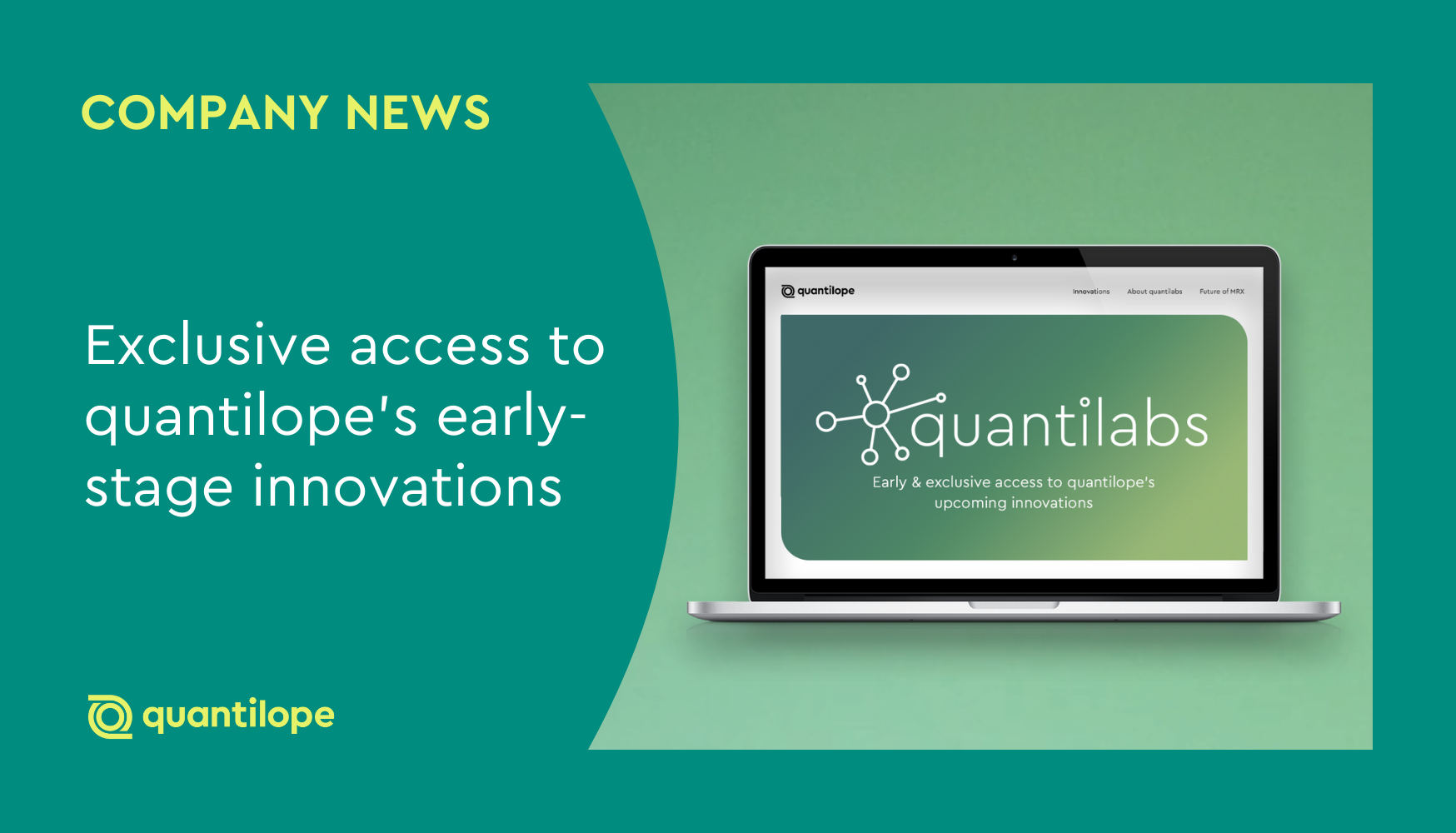This blog explores how to use a brand insights software or tool to improve your brand strategy - starting with what brand insights are, what they can help with, how to use brand insights tools, and brand insight examples.
Table of Contents
- What do brand insights help with?
- How to use a brand insights tool to improve branding strategy
- Brand insights examples
- Using quantilope for automated brand insights
What are brand insights?
Brand insights provide guidance on how to measure brand value through understanding a brand’s particular identity, consumer perceptions, strengths, weaknesses, and competitive stance. It’s any information that points to how well a brand is doing and where they might be able to improve customer pain points in order to grow.
Obtaining brand insights typically involves gathering current customer insights (or insights from a prospective target audience) about how they view your brand and interact with it in their customer journey (most commonly collected through an online market research survey). These survey insights might include metrics like customer satisfaction with a brand, brand loyalty, customer behavior/buying patterns, or specific brand associations.
Back to table of contents
What do brand insights help with?
Businesses that gather brand insights are better suited to create relevant services and offerings that are in line with customer expectations. Brand insights are relevant for a variety of business objectives - from tailoring marketing campaigns, developing better products and services, or improving customer experience, just to name a few. Brands can lean on their brand insights to make data-supported decisions, from brand tracking to marketing campaigns, knowing that the insights reflect actual or potential customer opinions.
Below are a few more in-depth examples of how a business might act on their brand insights:
Brand positioning
New businesses can lean on brand insights to create solid brand positioning, while existing businesses can lean on brand insights to refine their positioning over time to stay relevant.
Take for example, a CPG company that historically has used a ton of plastic in their packaging. Their brand insights from a recent market research survey shows that their customer base cares deeply about sustainability and are less than satisfied with the current packaging of the brand’s products.
The CPG brand considers these brand insights from their target audience, adapts their packaging approach to use 75% less plastic, and launches new brand positioning as a brand ‘for consumers who care’. This new positioning/value proposition resonates with their sustainably-focused demographic of users, invoking in them a sense of loyalty and authenticity (thus reducing customer churn).
Marketing
Brands can craft compelling marketing campaigns through the use of brand insights.
Whether it’s measuring brand equity, fine-tune marketing campaign phrasing (through a MaxDiff), identifying the most optimal channels (through a TURF), or gathering valuable feedback on assets through an A/B test, brands can ensure that whatever they communicate externally through their marketing efforts has been thoroughly tested among respondents that represent their target audience.
For example, say a social media company notices usage of its app has been trending down for several years. They run a brand insights study to get to the bottom of it and find out that many consumers consider the app for ‘older’ crowds. The brand uses this particular insight to base a new marketing campaign around - including young and ‘trendy’ celebrities as endorsers, modern and casual language, and popular music. They might even choose to A/B test the new campaign against any existing ones to see if it contributes to higher app usage - all driven by brand insight.
Product development
Leverage brand insights to develop new and innovative products.
Following current market research trends, brand insights can identify specific pain points or wishes customers have for a brand’s products or services. Brands can iterate on these insights to better cater to consumer needs. For example, consider a shampoo company that runs a brand insights study to capture metrics around brand satisfaction, brand associations, and more. The study shows high satisfaction with their products, but consumers also strongly associate the brand with being ‘tropical’ - perhaps due to its signature coconut scent.
The brand’s demographics skew younger - likely to be more frequent travelers. Given the association with being tropical, and knowing that many of their customers are likely young, on-the-go consumers, the brand begins the new product development process for travel-sized shampoo consumers can easily take with them to continue their routine away from home.
Customer experience
Brand insights point to concrete, actionable ways businesses can improve their customer experience - leading to higher customer retention.
Consider a hotel chain that decides to run a brand insights survey to get a pulse on how their travelers feel about their hospitality experience. The study includes metrics around the hotel’s brand perception, customer service, and overall experience at their brand’s hotel locations. The study finds that the majority of travelers are very happy with the hotel chain - especially the dining and accommodations, but 80% would be ‘very interested’ in having a digital room key card rather than a physical one, and 60% would prefer to check in via mobile app rather than the front desk. Their open-text feedback mention these features would create a more ‘modernized’ and ‘efficient’ hotel stay experience, so the hotel chain starts working on these new updates to offer their guests.
As another example, say an airline finds that their mobile app interface is a huge pain point for customers. In a quantitative study, customers say that things are difficult to find within the app, it’s often glitchy, and it’s hard to get in touch with a live chat agent. The airline considers this feedback and begins work on a revamped mobile app experience. When they re-field the study several months after the updates are complete, mobile app experience satisfaction significantly increased.
Competitive analysis
Use a brand insights study to measure brand performance in your category.
By understanding how consumers perceive one’s own brand in comparison to competitor brands, businesses can identify key competitive advantages along with possible areas for improvement or new market opportunities. For instance, a brand insights study might leverage a Multi-Implicit Association Test (MIAT) to understand subconscious perceptions respondents have toward your brand and a variety of others in your category. Check out an example of a MIAT in the airline category here.
Knowing where you stand out, and the things your brand is implicitly associated with can help shape strategic decision-making to stand out among competitors.
Back to table of contents
How to use a brand insights tool to improve branding strategy
There are many tools available to researchers looking to run a brand insights study. quantilope's brand tracking software offers real-time access to your brand insights, with the largest suite of automated advanced methods. Whether you want to run an ad-hoc brand insights study or implement a brand health tracking program to measure insights long term, quantilope makes it simple to drag and drop questions and methods into your survey. You can then connect to any panel provider you choose and monitor results as soon as fieldwork begins.
Below is an example of what a brand insights study might look like on quantilope’s platform:
-
Identify your target audience. Start by figuring out who you’re trying to reach with your brand insights study. Is it an audience representative of your current consumer base? Maybe it’s representative of the general population as a whole. Choose the audience that makes the most sense for the goals you’re trying to achieve with your study, then begin developing your questionnaire.
-
Create your brand insights survey. In this step, include any necessary demographic questions to screen out those who don’t fit into your target audience for the study (e.g. age caps, gender requirements, buyers of a certain product/category, etc.). Then begin adding questions that aim to answer your study’s objective. Do you want to learn about brand associations? Consider an implicit association test. Do you want to find out the optimal channels for your brand communications? Use a TURF. With 15 advanced methods to choose from and a library of pre-programmed usage and attitude questions, customize your ad-hoc or brand tracking survey without substantial manual effort.
-
Monitor and analyze your findings. As your study is in field, you can already begin to draft charts with collected data - and they’ll continue to automatically update throughout field as new respondent data is available. All quantilope studies provide statistical testing automatically, indicated through a simple hover of your mouse - and this feature is customizable in terms of significance threshold. Real-time monitoring and analysis makes it easy to get a jump start on your final reporting rather than having to wait until fieldwork is complete and a data processing teams send you your final data file before you can get started. If you’ve chosen to run a tracker, look for significant brand tracking metrics that signal new patterns or trends
-
Generate actionable insights. Once you’ve analyzed your data and pulled out the most interesting charts for your final dashboard report, it’s time to begin creating actionable headlines and insights for your stakeholders. If you get stuck, you can always leverage quantilope’s AI co-pilot, quinn, to help generate impactful brand insight takeaways by clicking ‘Hey quinn, write a chart title and description’ for each individual chart, or ‘Hey quinn, write a summary’ for your entire dashboard.

As for the specific types of brand insights you can run with quantilope, consider any of the following:
quantitative brand insights studies:
-
General consumer insights: Leverage quantilope’s Consumer Intelligence Platform to conduct comprehensive consumer research around your brand - such as consumer perceptions, attitudes, and behaviors. For these studies, use the pre-programmed library of questions and methods or start with a pre-populated, customizable survey template.
-
Competitive analysis: Compare your brand's performance and perception against competitors to get an idea of where you stand in the category. Use brand insight metrics such as brand awareness, brand satisfaction, or brand usage.
-
Target audience segmentation: Segment your target audience based on their underlying needs using quantilope’s Need-Based Segmentation method. Tailor branding strategies to different audience segments to increase relevance and engagement.
-
Product development insights: Gather feedback on existing products and potential product innovations through a Choice-Based Conjoint analysis which presents respondents with a number of product concepts - each with varying attributes. This type of study/analysis can let you know which features, price levels, and other aspects are most appealing to customers.
-
Marketing campaign optimization: Test different ideas for marketing campaigns or creative concepts through an A/B test. Use the findings to optimize brand messaging and drive increased brand awareness, engagement, and conversion.
-
Brand health tracking: Continuously monitor brand health metrics using quantilope’s Better Brand Health Tracking (BBHT) solution - based on the Ehrenberg-Bass Institute. BBHT leverages concepts known as Category Entry Points, Mental Availability, and Mental Advantage, which let brands know what brings shoppers to their category, which brands come to mind in those instances, and which brands perform better than expected (respectively).
qualitative brand insights studies:
For brands looking to gather qualitative brand insights, they can leverage quantilope’s inColor solution - a video feedback tool that captures consumer feedback in their own words, and automatically analyzes it for sentiments, keywords, and facial expressions. Trim collected videos, group them by sentiment or keyword, and create a comprehensive showreel to use in dashboards to supplement quantitative research, or, use as a separate valuable asset.
By harnessing the various capabilities of quantilope's Consumer Intelligence Platform, businesses can gain actionable insights into their brand and related consumer behavior, enabling them to refine and optimize branding strategies for greater impact.
Back to table of contents
Brand insights examples
Above we talked about several hypothetical consumer insight examples, and now we’ll explore three real world case studies from quantilope clients:
Re-positioning a beverage brand:
- Objective: Oatly, a leader in the fast-moving consumer goods space for oat-based dairy alternatives, came to quantilope to understand how to effectively shift its brand positioning away from a vegan-only lifestyle toward a more broad-reaching consumer base.
- Approach: Knowing any strategic positioning decisions needed to be grounded in data-driven market research insights, Oatly launched a brand perception study on the Consumer Intelligence Platform to analyze consumer attitudes, emotions, and associations related to the brand.
- Insights: Oatly was able to quickly generate meaningful insights about their target audience to clearly identify actionable consumer groups and any unmet customer needs for dairy alternatives. These insights were then published across several national newspapers and industry publications for increased brand visibility.
“Oatly operates with remarkable speed and detail. This requires comprehensive insights that must be fast and precise, and we realized we would not be able to accomplish what we had in mind through an external agency.”
- Sandra Schlicht, Business Insights Manager for Oatly DACH
Access the full Oatly case study here.
Monitoring the success of a financial services brand sponsorship:
- Objective: MoneyGram, an international peer-to-peer payments and money transfer company, landed a sponsorship deal with the Haas Formula 1 racing team and turned to quantilope to track how that sponsorship would shift brand perception from a traditional brick & mortar brand to a fast, high-tech, and innovative digital payments company.
- Approach: The team decided to run two separate trackers: one focused on the general population and another on Formula 1 racing fans. In a matter of months, the team was able to formulate their research objective, setup their trackers (18 in fact!), launch, and complete fieldwork to capture brand insights before the official announcement of their sponsorship; this even included time to run a pre-study leveraging a MaxDiff to identify which brand associations to test in the trackers.
- Insights: Just between the baseline wave and second wave of each tracker, MoneyGram saw a significant increase in brand awareness and brand consideration. They also surpassed a key competitor for brand recall for the first time in company history, and significantly more consumers viewed the brand as high-tech, trustworthy, and mobile compatible. Their sponsorship and marketing efforts were working.
“An ongoing challenge for insights professionals is to help executives turn insights into action. quantilope’s automated advanced methods are the key to delivering insights that executives not only trust but offer clear recommendations for impact.”
- Chris Wardlaw, Global Research and Insights Director at MoneyGram
Access the full MoneyGram case study here.
Inspiring award-winning brand campaigns:
- Objective: OMD - a leading media agency part of OMD Worldwide, supports their clients’ needs for data-backed campaign development through the use of quantilope’s Consumer Intelligence Platform. With quantilope, they aim to transform their market research process - particularly their processes for ad testing, ad campaign testing, and audience projects.
- Approach: Since partnering with quantilope, the insights team at OMD has run over 140 research projects across a wide range of client industries - from home appliances, to automotive, FMCG (fast-moving consumer goods), finance, and retail. OMD was also an early adopter of inColor, quantilope’s video-based qualitative research tool. With inColor, OMD could uncover target audience sentiment and tailor future marketing strategy decisions accordingly.
- Insights: From their research, the OMD team found that certain target groups, ad formats, and media can perform 15% to 20% better than other variations. This helps them quickly identify the ideal combinations to leverage in final brand assets for award-winning campaigns.
“Consumer research is becoming an increasingly valued component of a media strategist’s toolkit...for clients needing results fast, quantilope is a game changer. We can now quickly and easily run market research projects to fuel campaign development and as a result, build stronger campaigns for our clients.”
- Klaus Stinnertz, Managing Director at OMD Germany
Access the full OMD case study here.
Using quantilope for automated brand insights
quantilope is the end-to-end Consumer Intelligence Platform for whatever types of consumer insights your brand may need. From brand tracking to the largest suite of automated advanced quantitative research methods, and multiple specialized solutions - including Strategy, Innovation, Marketing, Shopper Insights, and Performance Marketing, quantilope is your one-stop-shop.
Run your brand insights studies on your own in a DIY fashion, leverage the as-needed assistance from a team of dedicated research consultants for a Do-It-Together (DIT) approach, or have your study fully managed by the quantilope team. quantilope’s AI co-pilot, quinn, also assists you throughout the end-to-end process from survey setup inspiration to generating chart titles and synthesizing report summaries.
To learn more about how quantilope can help with your brand insights needs, get in touch below!





